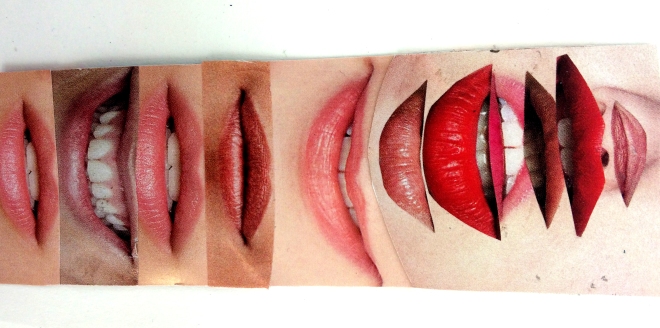
Month: March 2016
Collaging
I find the disconjointed array of combining found imagery very representational of the way our unconscious minds absorb information throughout the day and later recur within our dreams. Up to this point the collages I have created have used repetition to represent the murky waters between conscious and unconscious thought, I now plan on exploring repetition further.


Psychedelic Art
The psychedelic art movement was in full swing in the 1960’s, influenced and named after by the popularity of the hallucinogenic drug LSD. This movement can be characterized by intense use of colour, abstract circular designs, in addition to the subject matter, people, etc… being portrayed in an Art Nouveau style. The movement had a wider affect and had influence over fashion, philosophy, literature, and language.

The end of WWII saw a massive rise in births across America, known as ‘the baby boomers’, and by the 1960’s these babies were now young adults. There young adults questioned the materialism, political and conservative norms of their societies. The result of this was an movement seeking a discriminative free, equal society for all. Other movements were born out of this, such as the black power and feminist movements. It was a time where many controversial issues were publically discussed, enviromental issues, War in Vietnam, Nuclear weapons, sexual liberty. The non-conformist youth sought new experiences, experimenting with Eastern beliefs and psychedelic drugs in hope of spiritual awakening.
This art movement was greatly expressed in band posters, with music being pivitol within the psychedelic scene. Musicians like Janice Joplin, Jimi Hendrix, and the who were at the forefront, with music festivals being more than music, but a spiritual journey.
LSD Alternate States of Consciousness

LSD is referred to as a psychedelic drug, it posses psychoactive properties that alter perception and cognitive abilities by sending signals to the brain to release a high amounts of serotonin, and belong to a group of drugs known as hallucinogens. This class of drugs differs to others in a way that they create an altered state of consciousness, and has often been compared to other processes that have been thought to alter perception, such as dreaming, yoga, and religious ecstasy, to name a few.
The term Psychedelic originates from the Greek word that means psyche, soul, or mind, coined by psychiatrists in 1956, demonstrating their belief in how the drug has the potential to access the unconscious mind and open up hidden potentials within the human mind. But more recently the term entheogenic has been used, this term is used to describe a drug used in religious and shamanistic context. Used in rituals in an attempt to achieve transcendence, also found as a medical aid.
LSD Assisted Therapy
Ever since Dr. Hofmann developed LSD in 1938, the therapeutic effects have been recognised and studied. LSD has been given to treat a wide array of illnesses from alcoholics, to people suffering from mental illness, depression, anxiety, etc, to cancer patients. BRIDGING THE GAP Hofman and the scientists involved believed they could use the hallucinogenic properties of LSD to create psychotic disorders in healthy brains, in order for psychiatrists to experience what there patients were going through. It was also used as a way of helping their patients come to terms with what they were going through open up to their psychiatrists.
LSD and Creativity
By the 1960’s LSD had become an extremely popular drug, which had major influences on everything from pop culture, to underground art and music scenes. It shaped a generation of artists, through its mind opening abilities.
The above video shows how an artists depiction of himself changes over time after being given LSD, the self portraits go from realistic depiction to more abstracted shapes. This shows the alternating state of what his perceived reality is, below are the thoughts of the artists on each sketch. These demonstrate the changes in the artist’s perception/ connection with his usual conscious state.



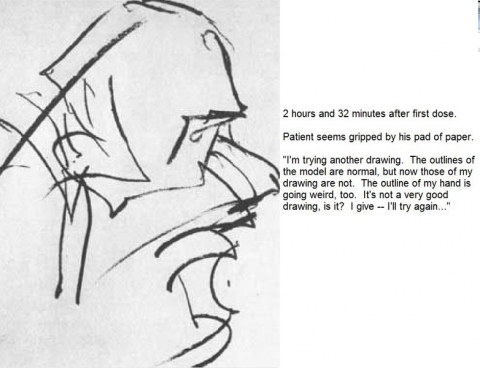
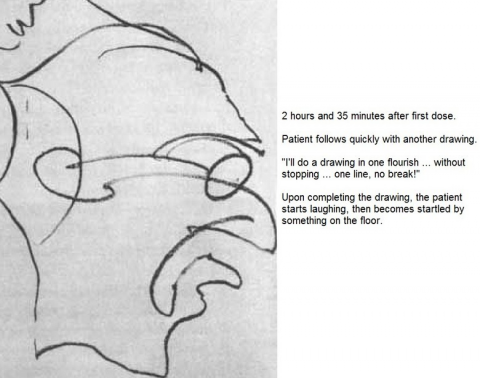


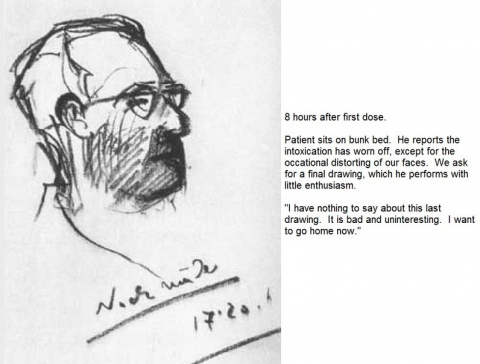
Desk
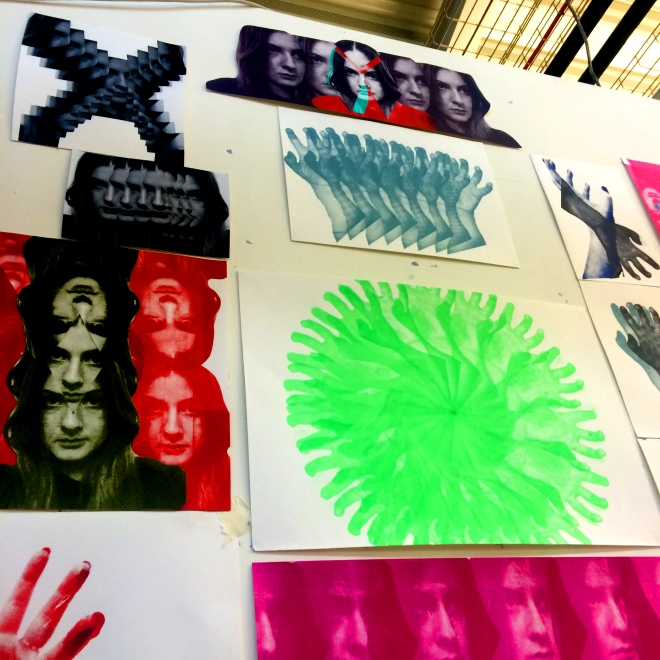
Surrealism
Put a pencil into someone’s hand and their seemingly random doodling of shapes, lines, and colours can all be dissected and analysed. But that is not to say you can analyse every piece of art work through a set of charts, the expression and its relevance of shape and colour are individual to each person. All of our gestures conscious or unconscious are for a simple reason, to connect our inner psyche with the outside world to form a bridge to those around us. This is seen in automatism, automatism was a major part of the surrealist movement, the artists involved, be that through automatic writing, drawing or painting were compelled to explore different levels of the unconscious mind (Tate, 2015). Andre Breton believed surrealism to be, “pure psychic automatism”, a movement void of the socially constructed conscious mind, a movement to free and express our subconscious feelings and desires that we ourselves may not be aware of. This seemingly random process of mark making, with no premeditated outcome or aim, allows for complete expression. Something Jung was trying to create by making mandalas.
Freud, widely considered the father of modern psychology, brought forth the idea of the mind being constructed of layers, the conscious, preconscious, and unconscious, to the scientific community. The surrealists found this notion particularly interesting, and sought to release there unconsciousness through automatism. Freud created a topographical model of the mind, using an analogy of an iceberg to describe the mind. The conscious mind, easily accessible information, the preconscious, a waiting room of memories easily brought into the consciousness, and finally the unconsciousness. Freud believed the unconsciousness stored all our primal, non-socially acceptable urges, along with repressed emotions, deemed too difficult to process and comprehend in our conscious state. Although Freud had a scientifically driven mind set, he believed artists had tapped into the unconscious mind, that they viewed the world in a different manner, surpassing scientific knowledge. This links to the research displayed in chapter 1, where autistic, injured and degenerate brain disorders, who possess brain function to be considered outside of the norm, resulted in heightened creativity.
Salvador Dali, his use of everyday objects/ beings in an unusual setting portrays the sense of disconnect from information received from the unconscious mind through dreams etc…
Collaging the Unconscious




Individuation
Individuation was coined by psychologist Carl Jung, the term describes a process where the unconscious is brought into consciousness, through dreaming, artistic creations or free association, to become fully aware of oneself, a process “necessary for the integration of the psyche” – Carl Jung. The initial idea behind individuation is a simple one, to fully understand yourself and the world we live we must externalise our unconscious minds through the use of different processes.
There is no one way to achieve this. The ego in Jungian theory, is the centre of consciousness, a faculty we posses that allows us to separate yourself from others, the ability to distinguish “I” as myself, the thing that gives us a sense of uniqueness within the world.
The conscious is the easily accessible part of our minds that process the information of everyday life, while the unconscious mind is inaccessible through conscious thought, a place where Jungian theory states hidden/ repressed thoughts and motives reside. And by releasing these repressed emotions, we can gain a better understanding of our daily actions. Jung sought to find a process to do this, he found creating mandalas daily mirrored his inner feelings.
What we also have in common is a conscious and an unconscious. With the conscious we are able to experience everyday life. The unconscious is a part of ourselves that kind of remains in the background, but is in no way inactive or inert. The unconscious is composed of hidden aspects of ourselves that continue to work on the conscious and thus on our everyday life, although we are not mostly not aware of it. The unconscious tries to bring man back into balance. In life we are not always able to do or be what we would like. Thus, the unconscious will influence our behaviour and actions in a way that will compensate. These unconscious tendencies can be stronger than our conscious, and can even go against our will. Thus we tell things in a flare of anger, of which we will be very sorry afterwards.
Although the structure is basic and simple, the contents require a much deeper understanding.
desk
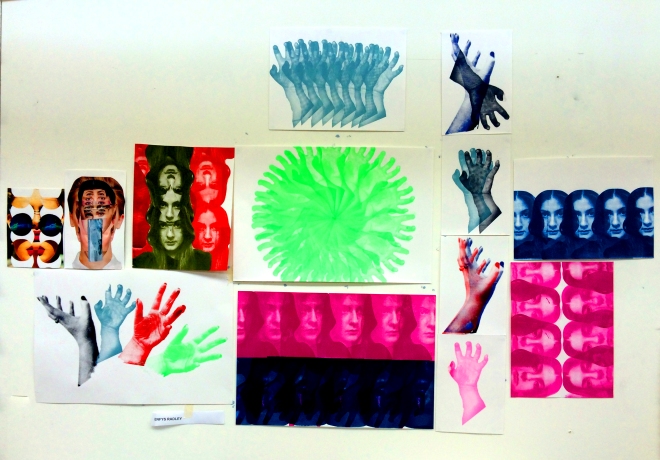
Repeated faces








